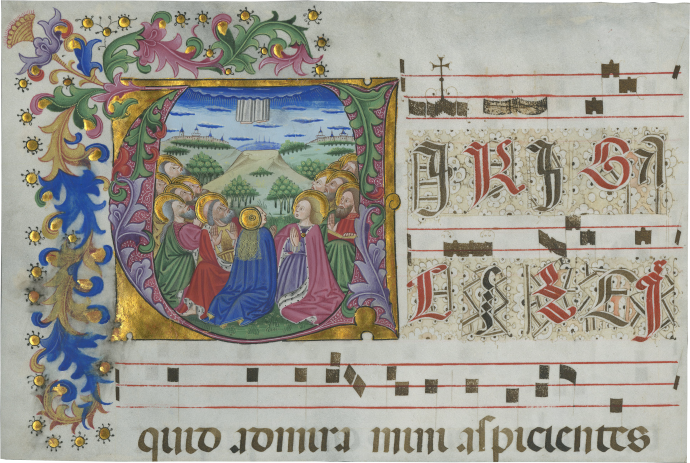


Franco-Flemish Painter (Circle of the Maestro del Messale Barbo)
, c. 1450-1475Franco-Flemish Painter (Circle of the Maestro del Messale Barbo)
Description
This impressive miniature and one sister leaf are uncommon evidence of a northern European artist working in Renaissance Italy. The miniature shows the lower legs and feet of Christ enveloped in blue clouds at the moment of the Ascension, with the Virgin Mary shown from behind, a gold halo partly obscuring her face, a tonsured John the Baptist, and the other apostles arrayed beside her gazing upwards, one holding a book, set in a hilly landscape with stands of bushy trees and crenellated towers in the distance. Colorful foliates with white filigree decorate the initial, set on burnished gold with sprays of foliates around the borders, with a single flower filled with mosaic gold in the top corner. The initial ‘V’ opens the chant Viri Galilaei quid admiramini aspicientes (Men of Galilee, why wonder you), Introit for Mass on the feast of the Ascension.
Considered to be French or Flemish, the artist was active in Brescia or Padua and collaborated with the so-called Maestro del Messale Barbo (active 1458-1467) on several manuscripts. Details of the artist’s work are reminiscent of French and Flemish painters, seen in the figures with heavy-lidded eyes, down-turned mouths, and rounded hands – all rendered with expressive hatchings. This presumed Franco-Flemish artist also decorated the borders with loose sprays of soft foliates, notably at odds with more densely packed borders favored by Italian illuminators. However, the parent manuscript was no doubt written in northern Italy and is decorated with distinctive washes of yellow over the penwork. Showing the same treatment of the faces and the same overall decorative motif, our artist’s hand also appears in an historiated initial ‘D’ on the first folio of a Psalter now in Oxford (figure 1, Bodleian Library MS Lat. liturg. a. 3; see Solopova 2013). The penwork is also closely comparable to other manuscripts with miniatures by the Master of the Barbo Missal, including a leaf from a Choir Psalter in Cleveland (figure 2, Cleveland Museum of Art, 2011.70; see Fliegel 1999, no. 77).
A sister leaf (Les Enluminures, MIN 19-21) depicting kneeling clerics with blue robes identifies the original owners of the parent manuscript as a community of secular canons affiliated with San Giorgio in Alga (Saint George in the Seaweed). A reform-minded congregation founded on a small island near Venice in the fifteenth century, the canons adopted religious practices from the Devotio Moderna of Northern Europe. A community of canons affiliated with San Giorgio in Alga was established in Brescia in the mid-1400s at San Pietro in Oliveto, and it is this Brescian community that perhaps commissioned the Gradual from which this cutting originates. Similar blue-robed canons appear in an historiated initial ‘N’ also from a Gradual and now in New York (figure 3, Columbia University, Rare Book and Manuscript Library, Plimpton MS 40A), probably also made for the canons at San Pietro in Oliveto.
The leaf is written in a Gothic rotunda in black ink with fragments of three registers of square notation on four-line staves in red (rastrum 31 mm.), abbreviated to 2- and 3-line staves opening the chant, with initials in red and black decorated with ornate purple and black penwork with washes of yellow; the verso with a fragment of the chant Petite et accipietis ending imperfectly at “...vobis omnis enim qui petit[...],”and written in pencil in French “album sur bleu.” The miniature with small abrasions, the left border rubbed, otherwise in excellent condition. The parchment with remnants of two former mounts, previously pasted into an album.
Provenance:
Unidentified French collection (from pencil inscription on verso, “album sur bleu”).
Literature:
S. Fliegel, The Jeanne Miles Blackburn Collection of Manuscript Illuminations, Cleveland, 1999, no. 77.
E. Solopova, Latin Liturgical Psalters in the Bodleian Library: A Select Catalogue, Oxford, 2013.